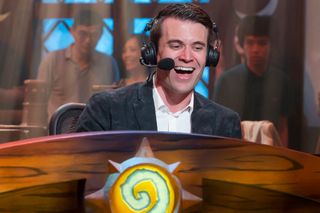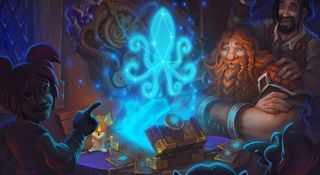Last weekend, eight of the best Hearthstone players from the Americas region stepped out of the Los Angeles sunshine and into a studio to battle it out for the Spring Championship. Inside they found a real life version of the game’s iconic tavern, wreathed in dry ice and complete with oversized ale barrels. On the line for the winner: $25,000 and a guaranteed spot at this year’s BlizzCon World Championship finals. That prize eventually went to Julien “Cydonia” Perrault-Harvey, a 31 year-old Canadian, who triumphed 4-3 in a nail-biting series.
Unlike the equivalent Europe event two weeks earlier, the Americas field entirely comprised lesser known ladder warriors and open tournament grinders who, having gathered enough tour points to qualify, had fought through the tough preliminary event. On the final day I spoke with Brian Kibler, there as parting of the casting team, to get a sense of how he sees the pro scene right now, and his take on overall health of Hearthstone, with challengers like Gwent and The Elder Scrolls: Legends waiting in the wings.

In addition to his illustrious record as an MTG pro, Brian was lead designer on the World of Warcraft Trading Card Game, which was the paper precursor for Hearthstone. He also done design work on numerous other collectible games, including Solforge. You can read more of his writing at bmkgaming and see him stream Hearthstone here. I hope you like dragons.
PC Gamer: How close do you think we are to seeing the Whispers of the Old Gods meta “solved”?
Brian “Brian Kibler” Kibler: I think there’s room for evolution. Even looking at the championships over the past few weeks, we’ve seen pretty significantly different lineups from Americas, Asia, and Europe. Here, [at the Americas Championship], there were seven Hunter decks, but there were very few in previous ones. C’Thun Druid went from having one representative to four or five here. So I think that even in an environment where a lot of very strong decks are well-known and well iterated-on, the format gives players opportunities to gain an edge by bringing different combinations or versions of those.
PCG: At Dreamhack Summer there were some unusual decks, like C’Thun Priest, but not so much in this tournament. Why do you think that was?
Kibler: I think that, for one, this is a group of, for the most part, relative newcomers to the tournament scene. They are, I’d imagine, less likely to feel comfortable taking big risks with their lineups. They’re likely to want to play something solid and safe, because if they play something out of leftfield and it goes poorly, that can reflect poorly on them. Whereas if they play good solid decks, it’s difficult for them to come off too poorly with those sort of decisions. It’s like, “Oh, I decided to bring Tempo Warrior and Aggro Shaman.” Okay, no one can really fault you for that. There’s definitely some risk-aversion based on the stakes and the fact that these players are less established than some of the players in other big events.

PCG: This season the Americas championship featured a group of relative unknowns who qualified ahead of established pros. One of our contributors recently wrote an article elsewhere suggesting that the press and casters have failed in building storylines around less-famous players. What are your thoughts on that?
PC Gamer Newsletter
Sign up to get the best content of the week, and great gaming deals, as picked by the editors.
Kibler: I think that we saw, in the previous years of competitive Hearthstone, there was a big focus on invitationals. So you got a lot of the same big names over and over—which was great for building the profile of those players, and the viewerships of the competitive scene. It wasn’t necessarily as great for the player at home who wanted to get into competitive Hearthstone and didn’t really have the opportunity. I think the structure of the Hearthstone Championship Tour this year is much more fair for everyone. Players who didn’t have the chance because they weren’t high profile in previous years now have the opportunity to get involved in high level competitive Hearthstone. It is imperative that we contextualize what that means to those players, who they are, and be able to tell their stories at events. Last season it was more Europe that had the unknown field, but then we got to know those players throughout the event. A lot of people now have knowledge of who they are, and feel like they’re a major part of the European community now. I think we’ll see the same thing with the players from this tournament as well.
PCG: Do you think Blizzard should look at different ways of releasing cards beyond huge sets and adventures, to keep the meta moving a bit more?
I think it’s important for [Wild] to feel like it’s a format that matters, for it to have some kind of support...
Kibler: I think that having additional injections of cards into the format could help shake things up on a regular basis. Personally, I’d love to see more stuff changing more frequently. Not necessarily changing, but more stuff being introduced. I know that there are a lot of people who would love to see regular balance changes, like patches that make Doomhammer or Totem Golem different.
PCG: Not stronger, I assume.
Kibler: [Laughs] “Different,” we’ll say. My perspective is that I definitely like the approach that Blizzard has to the game in general of allowing the introduction of cards to shift the metagame, as opposed to having a heavy-handed and frequent approach to nerfing and buffing cards. I do think that—and I’ve seen this in other games I’ve played—that players get exhausted by constant change. They’ll come back and the deck that they played doesn’t work, and then they just leave. It’s a huge, huge risk. I think that having the ability to add cards on a regular basis, or to have formats, like with the introduction of Standard, that don’t use all the cards; maybe changing what exactly it means to be in the Classic set, or what is in Standard moving forward—all of those are great tools for shifting the metagame around in a way that isn’t just changing cards on a frequent basis, which I do think is a better way to go about it.

PCG: Now that Standard has been in place for a while, how successful do you think the format split has been?
Kibler: I have not played a single game of Wild. I know a lot of people who haven’t either. I think it’s important for it to feel like it’s a format that matters, for it to have some kind of support, whether third party or official Blizzard support. I’d like to see organizers running Wild events, because I think that actually having a spotlight shined on the format would increase the level of interest in it among the community. Having multiple formats that players feel like they can meaningfully compete in makes any stagnation in either of them less of an issue. So you’re bored of playing Standard maybe, okay, you can go play Wild and there’s this Wild event you can practice for instead.
PCG: If you were going to play Wild right now, what kind of deck would you initially try?
Kibler: I’m sure I’d play like N’Zoth Priest, just because it seems like it would be super powerful, and I keep trying to play Priest decks in Standard and they keep losing. [Laughs] [Since this interview Kibler has started experimenting with N’Zoth Priest in Wild on stream, and doing very well with it - Ed]
On the next page: The Yogg arms race and how Kibler sees his own future.
With over two decades covering videogames, Tim has been there from the beginning. In his case, that meant playing Elite in 'co-op' on a BBC Micro (one player uses the movement keys, the other shoots) until his parents finally caved and bought an Amstrad CPC 6128. These days, when not steering the good ship PC Gamer, Tim spends his time complaining that all Priest mains in Hearthstone are degenerates and raiding in Destiny 2. He's almost certainly doing one of these right now.
Most Popular


